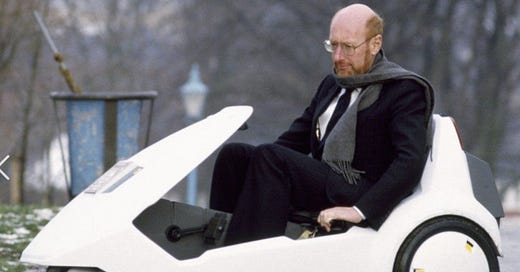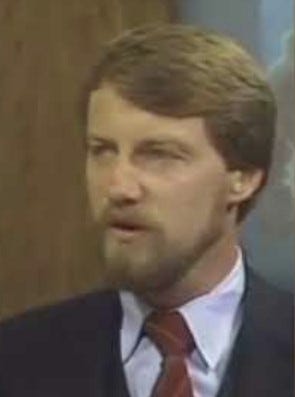This is a short story about two pioneers of microcomputer industry. They were different in many aspects: one was British, self-educated in electronics; the other was American, with a PhD in computer science. There are a few things they had in common, though, other than both of them being red-bearded.
Sir Clive Sinclair
Clive Marles Sinclair1 was born on July 30, 1940, in a suburb of London. His grandfather and father were both engineers, specialized in shipbuilding. Clive was a good student, especially in mathematics, and could have gone to university, but he chose to pursue his interests in electronics on his own.
Sinclair is best known for his role in the home computer revolution in the late 1970s and early 1980s. The series of Sinclair cheap home computers culminated in the ZX Spectrum which was the best-selling computer produced outside of the U.S. with over 5 million units sold. His company, Sinclair Research grew quickly, and the former employees fondly remember Clive Sinclair as a generous and fun-loving boss, albeit with somewhat short temper. The office parties included lots of alcohol and Sir Clive was never hesitant to join in, but it doesn’t seem he ever developed a drinking problem.
Clive Sinclair was not a natural businessman, and he never claimed to be. In 1984, he over-invested into two projects (Sinclair QL business computer and C5 electric vehicle) that turned out to be colossal market failures. By March 1986, he ran out of money and had to sell his company to Amstrad for 5 million GBP. The strain of running the business took its toll on his personal life as well: in 1985, he divorced his wife Ann, with whom he had three children.
Sinclair first came up with the idea of a miniature TV set in the 1960s and developed a prototype in 1966. Named Microvision, it was a hit of the 1966 Radio Show. The first model that was actually sold to customers was the TV1A in 1977, soon followed by the TV1B and the TV1C. His final attempt, the flat-screen TV80, was also a commercial failure.
Another passion was electric vehicles. He first started thinking about them as a teenager, and in the early 1970s started investigating a design. In late 1979, he approached Tony Wood Rogers to help him build a prototype of an electric vehicle. The result was C5, released in 1985. It was a commercial failure that ruined Sinclair Research.
There are a few TV interviews with Clive Sinclair that can be found on YouTube. Sir Clive spoke confidently, in a deep voice and always had insightful views on technology and the future in general. He was active in British MENSA and served as the chairman from 1980 to 1997.
Sir Clive Sinclair died on 16 September 2021, long after his visions of small-screen TVs and electric vehicles became commonplace.
Dr Gary Kildall
Gary Arlen Kildall2 was born on May 19, 1942, in Seattle. His grandfather and father were both seamen and ran the Kildall Nautical School. Gary was not a good student, except in mathematics, but managed to enter the University of Washington with hopes of becoming a math teacher.
Kildall is best known for his early operating system for microcomputers, called CP/M. From 1977 to 1983, CP/M was established as the standard operating system for business microcomputers, selling over five million copies. His company, Digital Research grew quickly, and the former employees fondly remember Gary Kildall as a generous and fun-loving boss, albeit disorganized. The office parties included lots of alcohol and Gary was never hesitant to join in - over time he developed a drinking problem.
Gary Kildall was not a natural businessman, and he never claimed to be. He spent almost two years developing a PL/I compiler for 8-bit microcomputers and was late in porting CP/M to Intel 8086; then he failed to secure a deal with IBM to provide them with an operating system for the upcoming IBM PC, and by late 1983, CP/M fell behind MSDOS as the predominant operating system for microcomputers. He stepped down as the CEO but remained involved with the company until it was sold to Novell in 1991 for 120 million USD. The pressure of running the company affected his personal life: in 1985, he divorced his wife Dorothy, with whom he had two children.
Kildall was among the first to recognize the viability of microprocessors as general-purpose central computing units. In 1973 he developed the first high level programming language specifically aimed at microcomputers: PL/M. Later, he ported PL/I to microcomputers and finally he developed a version of Logo, which he hoped would replace BASIC as the beginners’ language. Interestingly enough, microcomputers continued to be programmed mostly in assembly languages at least until mid-1980s.
He also pioneered the use of optical disks for storage. In 1984, Kildall and Tom Rollander founded Activenture to create KnowledgeDisc, the first electronic encyclopedia on CD. Its advanced indexing, search, and links were ahead of the market - few systems had CD drives then - so it met only limited success.
From 1983 to 1989, Kildall co-hosted the TV show Computer Chronicles. He spoke nervously, often rushing through sentences, but his technical competence came across clearly. He also contributed articles to magazines like Byte.
Dr Gary Kildall died on July 11, 1994, after witnessing microcomputers’ global dominance, programmed in high-level languages and using compact discs—just as he had envisioned.
Rodney Dale: The Sinclair Story covers Sinclair’s professional life until 1985.
Gary Kildall’s: Computer Connections People, Places, and Events in the Evolution of the Personal Computer Industry is partially available for download. It covers Gary’s life and career until approximately 1980.





